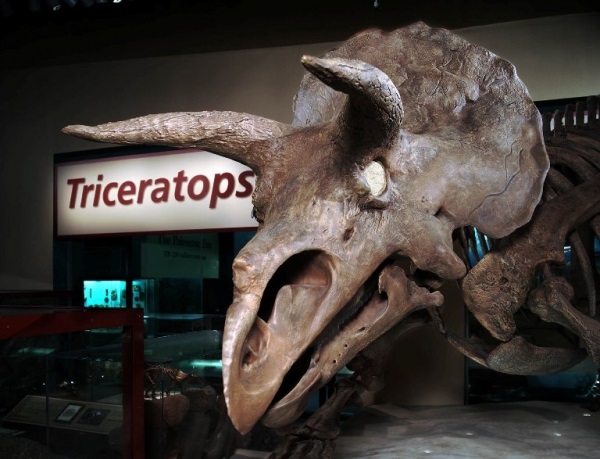Study: Three-horned Dinosaur Triceratops Took Two Million Years To Evolve
| Kristina Fernandez | | Jul 02, 2014 05:25 AM EDT |
(Photo : Reuters/Smithsonian/D.E. Hurlbert)
A new study published Monday concluded that the famous Triceratops - named and known for their three prominent horns - took around two million years of evolution to arrive at their signature form.
According to the 15-year study conducted by the researchers at the Montana State University, the Triceratops did not always have the magnificent set of horns they are so well known for. The dinosaur once had a longer beak and shorter horns, which over the course of over a million years of evolution developed into a more deadly display.
Like Us on Facebook
Year after year, researchers returned to the Hell Creek Formation in Montana where the largest specimen of Triceratops are found.
Scientists have long struggled to find the relationship between the triceratops prorsus, characterized by short beak and long nasal horn, and triceratops horridus whose main feature is a long beak and short nasal horn.
Previous researches theorized that the slight difference in the specimens' facial profiles determine between male and female Triceratops. Other groups of researchers believed that prorsus and horridus are two separate evolved forms of the three-horned dinosaur.
However, John Scanella and colleagues ascertained that "over one to two million years at the end of the Cretaceous Period, Triceratops went from having a small nasal horn and long beak to having a long nasal horn and shorter beak."
"This striking change in physical display suggests they evolved," Scanella explained, "though it's difficult to say what drove the change."
Based on their study of 50 triceratops skull specimens excavated in the badlands of Eastern Montana, the team also concluded that the dinosaur's horns and skull changed as individual creature aged.
Triceratops roamed the earth near the final stage of the Cretaceous period. They arrived at their popular form around half a million years before the dinosaurs went extinct.
Scanella's study came out with the June 30 issue of the journal "Proceedings of the National Academy of Sciences."
Tagstriceratops, three-horned dinosaur, Scanella, Hell Creek Formation, evolution
©2015 Chinatopix All rights reserved. Do not reproduce without permission
EDITOR'S PICKS
-

Did the Trump administration just announce plans for a trade war with ‘hostile’ China and Russia?
-

US Senate passes Taiwan travel bill slammed by China
-

As Yan Sihong’s family grieves, here are other Chinese students who went missing abroad. Some have never been found
-

Beijing blasts Western critics who ‘smear China’ with the term sharp power
-

China Envoy Seeks to Defuse Tensions With U.S. as a Trade War Brews
-

Singapore's Deputy PM Provides Bitcoin Vote of Confidence Amid China's Blanket Bans
-

China warns investors over risks in overseas virtual currency trading
-

Chinese government most trustworthy: survey
-

Kashima Antlers On Course For Back-To-Back Titles
MOST POPULAR
LATEST NEWS
Zhou Yongkang: China's Former Security Chief Sentenced to Life in Prison

China's former Chief of the Ministry of Public Security, Zhou Yongkang, has been given a life sentence after he was found guilty of abusing his office, bribery and deliberately ... Full Article
TRENDING STORY

China Pork Prices Expected to Stabilize As The Supplies Recover

Elephone P9000 Smartphone is now on Sale on Amazon India

There's a Big Chance Cliffhangers Won't Still Be Resolved When Grey's Anatomy Season 13 Returns

Supreme Court Ruled on Samsung vs Apple Dispute for Patent Infringement

Microsoft Surface Pro 5 Rumors and Release Date: What is the Latest?










